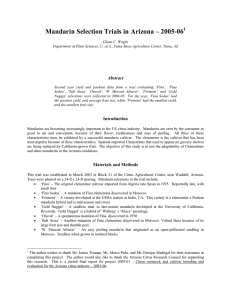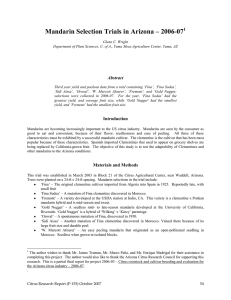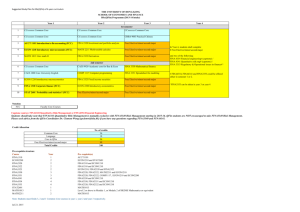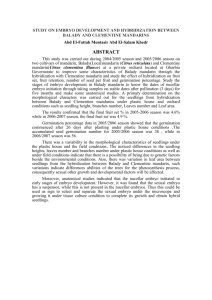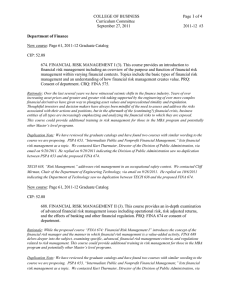Mandarin Selection Trials in Arizona – 2004-05 Abstract 1
advertisement
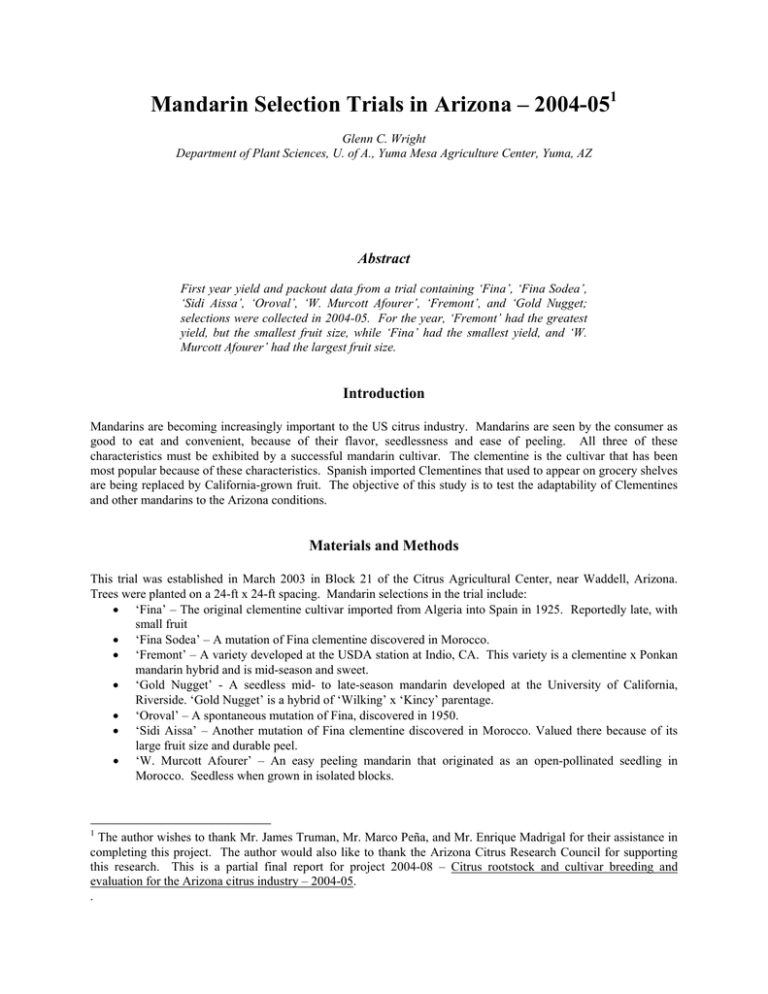
Mandarin Selection Trials in Arizona – 2004-051 Glenn C. Wright Department of Plant Sciences, U. of A., Yuma Mesa Agriculture Center, Yuma, AZ Abstract First year yield and packout data from a trial containing ‘Fina’, ‘Fina Sodea’, ‘Sidi Aissa’, ‘Oroval’, ‘W. Murcott Afourer’, ‘Fremont’, and ‘Gold Nugget; selections were collected in 2004-05. For the year, ‘Fremont’ had the greatest yield, but the smallest fruit size, while ‘Fina’ had the smallest yield, and ‘W. Murcott Afourer’ had the largest fruit size. Introduction Mandarins are becoming increasingly important to the US citrus industry. Mandarins are seen by the consumer as good to eat and convenient, because of their flavor, seedlessness and ease of peeling. All three of these characteristics must be exhibited by a successful mandarin cultivar. The clementine is the cultivar that has been most popular because of these characteristics. Spanish imported Clementines that used to appear on grocery shelves are being replaced by California-grown fruit. The objective of this study is to test the adaptability of Clementines and other mandarins to the Arizona conditions. Materials and Methods This trial was established in March 2003 in Block 21 of the Citrus Agricultural Center, near Waddell, Arizona. Trees were planted on a 24-ft x 24-ft spacing. Mandarin selections in the trial include: • ‘Fina’ – The original clementine cultivar imported from Algeria into Spain in 1925. Reportedly late, with small fruit • ‘Fina Sodea’ – A mutation of Fina clementine discovered in Morocco. • ‘Fremont’ – A variety developed at the USDA station at Indio, CA. This variety is a clementine x Ponkan mandarin hybrid and is mid-season and sweet. • ‘Gold Nugget’ - A seedless mid- to late-season mandarin developed at the University of California, Riverside. ‘Gold Nugget’ is a hybrid of ‘Wilking’ x ‘Kincy’ parentage. • ‘Oroval’ – A spontaneous mutation of Fina, discovered in 1950. • ‘Sidi Aissa’ – Another mutation of Fina clementine discovered in Morocco. Valued there because of its large fruit size and durable peel. • ‘W. Murcott Afourer’ – An easy peeling mandarin that originated as an open-pollinated seedling in Morocco. Seedless when grown in isolated blocks. 1 The author wishes to thank Mr. James Truman, Mr. Marco Peña, and Mr. Enrique Madrigal for their assistance in completing this project. The author would also like to thank the Arizona Citrus Research Council for supporting this research. This is a partial final report for project 2004-08 – Citrus rootstock and cultivar breeding and evaluation for the Arizona citrus industry – 2004-05. . The original plan was for there to be 15 trees of each variety. However due to mistakes while the trees were propagated and subsequent tree death, there range between 10 and 21 trees of each variety, except for ‘W. Murcott Afourer’ with 6 trees, and ‘Gold’ Nugget’ with 4. All trees are on Carrizo citrange rootstock. Irrigation is border flood, and normal cultural practices are used. Yield data is collected during the winter, and 2004-05 was the first harvest year for this trial. For 2004-05, trees were strip-picked on 12-15-04, except the ‘W. Murcott Afourer’ which were strip picked on 1-14-05. There was no yield for ‘Gold Nugget’ in 2004-05. For each harvest date, the entire quantity of harvested fruit from each tree was passed through an automated electronic eye sorter (Autoline, Inc., Reedley, CA), which provides weight, color, exterior quality and size data for each fruit. Fruit packout data is reported on a percentage basis. All data was analyzed using SPSS 11.0 for Windows (SPSS Inc., Chicago, Illinois). Results and Discussion First year yield for the trial is shown in Figure 1. There was little difference between the selections, except that ‘Fremont’ had the greatest yield, and ‘Fina’ had the least. All other selections were intermediate between these two. Packout of the cultivars is shown in Table 1. Trees of ‘W. Murcott Afourer’ had the largest fruit, while those of ‘Fremont’ had the smallest. ‘Fina Sodea’ and ‘Sidi Aissa’ fruit appear to be slightly larger than ‘Fina’ fruit, but ‘Oroval’ fruit are the largest of the four ‘Clementine’ selections in the trial. More yield and packout data need to be taken to confirm these trends. 16 A 14 AB Yield (lbs. per tree) 12 AB 10 AB AB 8 6 B 4 2 an da rin e fo ur co tt A W .M Si di Ai ss a ur er M C le m en tin en ti n e al C le m C le m en tin e O ro v So de a M an da rin Fi na Fr em on t Fi na C le m en ti n e 0 Cultivar Figure 1. Yields of six mandarin selections on Carrizo citrange rootstock for 2004-05 season. Overall yield for the year can be compared using the uppercase letters above each stacked bar. Table 1. Packout of six mandarin selections on Carrizo citrange rootstock for 2004-05 season. Packout (%) Selectionz Colossal Mammoth Jumbo Large ‘W. Murcott Afourer’ 8.1 a 17.4 a 36.9 a 22.2 c ‘Fina’ 1.8 b 4.4 bc 19.8 b 37.6 ab ‘Fina Sodea’ 2.8 b 8.5 bc 35.1 ab 36.8 ab ‘Oroval’ 2.5 b 12.7 ab 35.2 ab 28.0 bc ‘Sidi Aissa’ 0.0 b 4.1 bc 27.4 ab 42.0 a ‘Fremont’ 1.3 b 1.5 c 2.5 c 10.1 d z Values are the means of 6 to 21 trees. y Means separation in columns by Duncan’s Multiple Range Test, 5% level. Medium 8.1 d 29.0 ab 13.9 cd 17.7 bcd 22.6 abc 33.9 a Small 3.3 b 7.5 b 2.8 b 3.2 b 3.3 b 50.0 a
